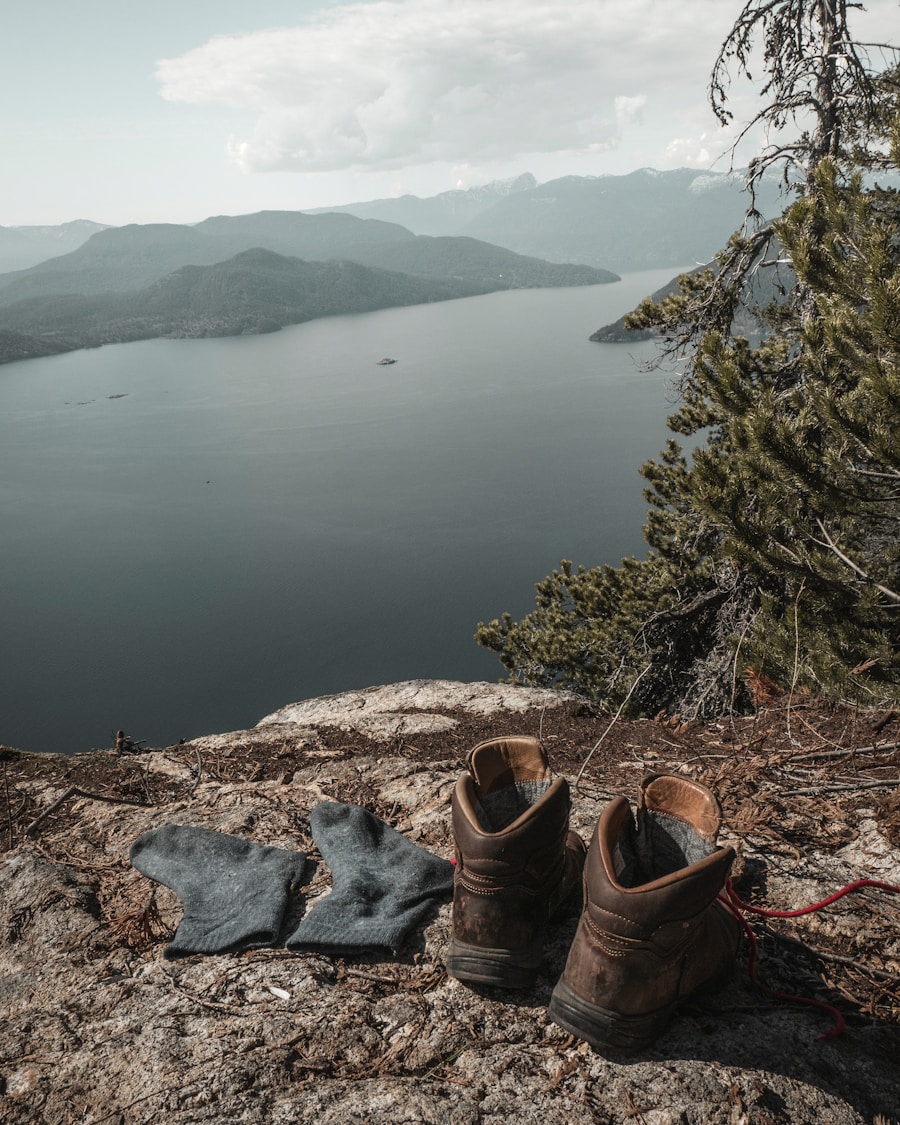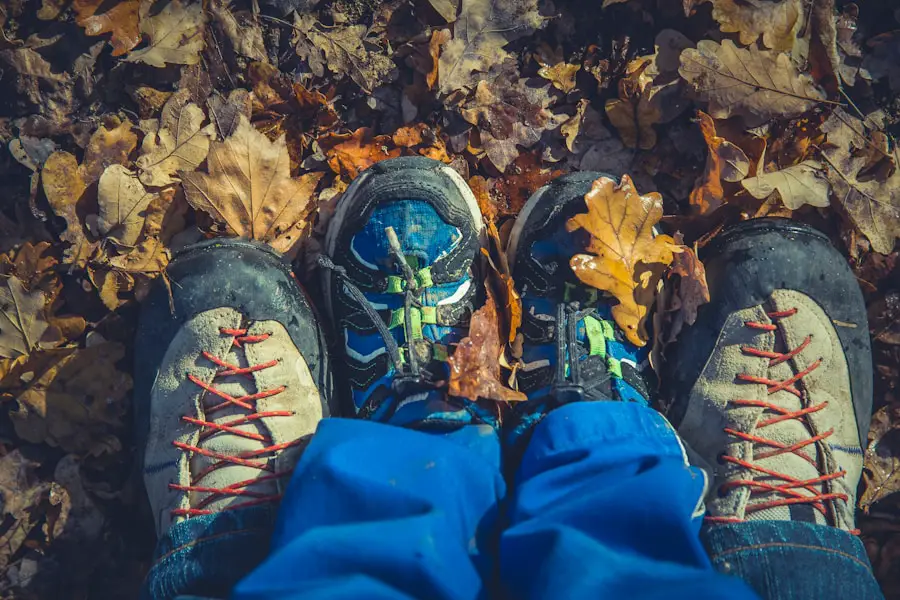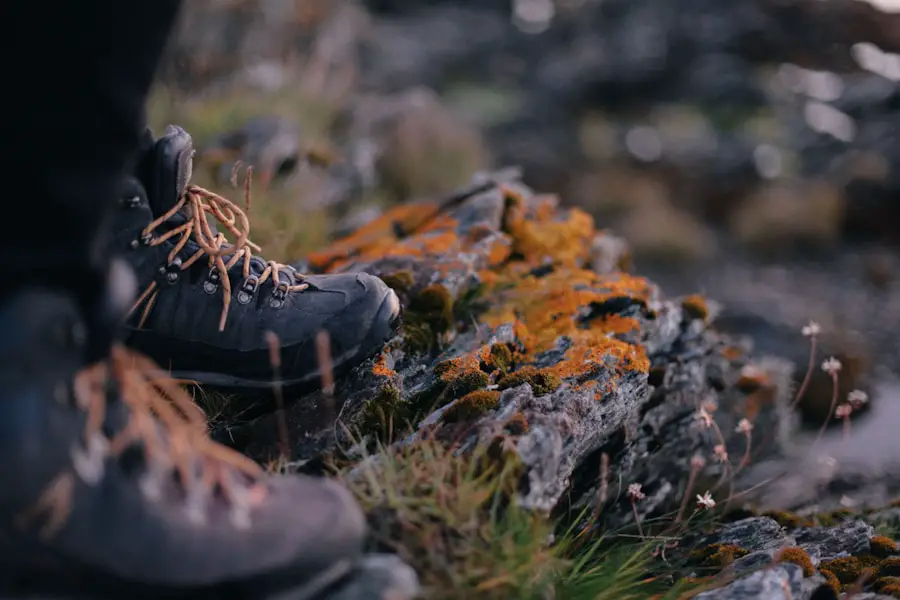Hiking boots are essential gear for outdoor enthusiasts, and they come in various types designed to cater to different terrains and hiking styles. Broadly, hiking boots can be categorized into three main types: lightweight hiking shoes, mid-cut hiking boots, and heavy-duty backpacking boots. Lightweight hiking shoes are ideal for day hikes on well-maintained trails.
They offer flexibility and comfort, making them suitable for those who prioritize speed and agility over rugged support. These shoes typically feature a breathable mesh upper and a flexible sole, allowing for natural foot movement while providing adequate traction. Mid-cut hiking boots strike a balance between support and weight.
They are designed for more challenging trails that may include uneven terrain or moderate elevation changes. These boots often feature a stiffer sole than lightweight shoes, providing better stability and support for the ankles. The mid-cut design helps protect the ankles from twists and turns, making them a popular choice for hikers who venture into more demanding environments.
Heavy-duty backpacking boots, on the other hand, are built for serious trekkers who carry heavy loads over long distances. These boots are characterized by their robust construction, offering maximum support and durability. They often come with a high-cut design that provides excellent ankle support, making them suitable for rugged terrains and multi-day hikes.
Key Takeaways
- Hiking boots come in different types such as trail shoes, day hiking boots, and backpacking boots, each designed for specific hiking needs.
- When choosing hiking boots, consider factors like the type of terrain, weather conditions, and ankle support needed for the hike.
- Finding the right fit for hiking boots involves considering factors like foot shape, size, and trying on boots with the socks you plan to wear while hiking.
- Hiking boots are made from materials like leather, synthetic fabrics, and waterproof membranes, with different construction methods for durability and support.
- Hiking boot features and technology include traction soles, waterproofing, insulation, and shock absorption, enhancing comfort and performance on the trail.
Factors to Consider When Choosing Hiking Boots
Terrain and Traction
The type of terrain you will be hiking on is a critical consideration. For instance, if you plan to hike on rocky or uneven surfaces, you will need boots with a stiffer sole and enhanced traction to prevent slips and falls. Conversely, if your hikes are primarily on well-maintained paths, a lighter shoe may suffice.
Weather Conditions
Another important factor to consider is the weather conditions you are likely to encounter. Waterproof boots are essential for wet or muddy conditions, while breathable options are preferable in hot climates to prevent overheating.
Fit, Weight, and Budget
It’s also crucial to think about the fit of the boot; a snug fit is essential to prevent blisters and discomfort during long hikes. Additionally, consider the weight of the boots, as heavier boots can provide more support but may lead to fatigue over long distances, while lightweight options can enhance speed but may lack the necessary support for challenging hikes. Finally, consider your budget, as while investing in high-quality boots can be beneficial in the long run, there are also many affordable options that provide good performance without breaking the bank.
Finding the Right Fit for Your Hiking Boots

Finding the right fit for your hiking boots is paramount to ensuring a comfortable hiking experience. A well-fitting boot should feel snug but not overly tight; there should be enough room in the toe box to wiggle your toes without feeling cramped. When trying on boots, it’s advisable to wear the same type of socks you plan to use while hiking, as this can affect the fit significantly.
It’s also best to try on boots later in the day when your feet are slightly swollen from daily activities; this will give you a more accurate sense of how they will feel during extended wear. To assess the fit properly, walk around in the boots on different surfaces if possible. Pay attention to any pressure points or areas of discomfort that may indicate an improper fit.
A good rule of thumb is to ensure that there is about a thumb’s width of space between your longest toe and the front of the boot when standing upright. Additionally, consider how the heel fits; it should not lift excessively when walking, as this can lead to blisters and chafing. If you have specific foot issues such as flat feet or high arches, look for brands that offer specialized insoles or arch support options.
Materials and Construction of Hiking Boots
| Brand | Material | Construction | Weight |
|---|---|---|---|
| Salomon | Gore-Tex, leather, rubber | Advanced Chassis, Sensifit | 1.1 lbs |
| Merrell | Leather, mesh, Vibram rubber | Strobel construction, Air Cushion | 1.2 lbs |
| Keen | Waterproof leather, breathable mesh | KEEN.DRY, KEEN.ALL-TERRAIN rubber outsole | 1.3 lbs |
The materials used in hiking boots play a significant role in their performance, durability, and comfort. Most hiking boots are constructed from either leather or synthetic materials, each offering distinct advantages. Leather is known for its durability and water resistance; full-grain leather boots can withstand harsh conditions and provide excellent protection against abrasions.
However, they tend to be heavier and require a longer break-in period compared to synthetic options. On the other hand, synthetic materials such as nylon or polyester are lighter and often more breathable, making them suitable for warmer climates or shorter hikes. The construction of hiking boots also varies significantly between models.
Many high-quality boots feature a waterproof membrane, such as Gore-Tex, which allows moisture to escape while preventing water from entering. This feature is particularly beneficial for hikers who frequently encounter wet conditions or stream crossings. Additionally, the sole construction is crucial; Vibram soles are renowned for their superior traction and durability on various surfaces.
The midsole material also affects comfort; EVA foam is commonly used for cushioning and shock absorption, while polyurethane offers greater durability but can be stiffer.
Hiking Boot Features and Technology
Modern hiking boots come equipped with various features and technologies designed to enhance performance and comfort on the trail. One notable feature is the presence of advanced cushioning systems that provide shock absorption during long hikes. Brands like Merrell and Salomon have developed proprietary technologies that incorporate specialized foam or gel inserts to reduce fatigue and improve overall comfort.
Another important feature is the lacing system; many hiking boots now utilize quick-lace systems that allow for easy adjustments on the go. This can be particularly useful when traversing uneven terrain where foot movement may require frequent tightening or loosening of laces. Additionally, some models include features like ankle support systems or reinforced toe caps that provide extra protection against rocks and roots encountered on trails.
Ventilation is another critical aspect of hiking boot design; many models incorporate mesh panels or breathable linings that help regulate temperature and moisture inside the boot. This is especially beneficial during warmer months when excessive heat can lead to discomfort or blisters. Furthermore, some brands have begun integrating sustainable materials into their designs, appealing to environmentally conscious consumers who seek eco-friendly options without sacrificing performance.
Proper Care and Maintenance of Hiking Boots

Proper care and maintenance of hiking boots are essential for prolonging their lifespan and ensuring optimal performance on the trail. After each hike, it’s important to clean your boots thoroughly to remove dirt, mud, and debris that can cause wear over time. Use a soft brush or cloth to gently scrub away any buildup, paying special attention to crevices where dirt can accumulate.
For leather boots, applying a specialized leather cleaner can help maintain their suppleness and prevent cracking. Waterproofing is another critical aspect of boot maintenance; even if your boots are designed with waterproof materials, regular treatment with a waterproofing spray or wax can enhance their water resistance over time. This is particularly important if you frequently hike in wet conditions or through muddy trails.
Additionally, allowing your boots to dry naturally after exposure to moisture is crucial; avoid placing them near direct heat sources as this can damage the materials. Storage also plays a vital role in maintaining your hiking boots’ integrity. Store them in a cool, dry place away from direct sunlight to prevent degradation of materials.
Using boot trees or stuffing them with newspaper can help maintain their shape during storage. Regularly inspecting your boots for signs of wear—such as frayed laces or worn-out soles—can help you address issues before they become significant problems.
Breaking in Your New Hiking Boots
Breaking in new hiking boots is an essential step that should not be overlooked before embarking on longer hikes. New boots often require a period of adjustment as they conform to the unique shape of your feet; this process helps prevent blisters and discomfort during actual hikes. A common recommendation is to start by wearing your new boots around the house or during short walks to allow your feet to acclimate gradually.
Gradually increasing the duration and intensity of wear is key; consider taking them on short day hikes where you can monitor how they feel over varying terrains. Pay attention to any areas of discomfort or pressure points that may arise during this process; if certain spots consistently cause pain, it may indicate that adjustments are needed in terms of fit or lacing techniques. Some hikers find it beneficial to use specialized blister prevention products during this break-in period, such as blister pads or friction-reducing socks.
It’s also important to remember that breaking in times can vary significantly depending on the boot’s material and construction; leather boots may require more time compared to synthetic options due to their stiffer nature. Be patient during this process; rushing into longer hikes with unbroken-in boots can lead to painful blisters or injuries that could sideline you from future adventures.
Top Hiking Boot Brands and Models
The market is filled with reputable brands known for producing high-quality hiking boots that cater to various needs and preferences. Merrell is one such brand that has garnered a loyal following among outdoor enthusiasts due to its commitment to comfort and performance. The Merrell Moab series is particularly popular for its lightweight design combined with excellent traction and support, making it suitable for both casual hikers and serious trekkers alike.
Salomon is another brand renowned for its innovative technologies and stylish designs. The Salomon X Ultra series features advanced cushioning systems and aggressive outsoles that provide exceptional grip on slippery surfaces, making them ideal for challenging terrains. For those seeking rugged durability combined with classic aesthetics, Danner offers a range of leather hiking boots known for their craftsmanship and longevity; models like the Danner Mountain Light are celebrated for their timeless design and reliable performance.
Other notable brands include Lowa, known for its German engineering and attention to detail; Vasque, which offers a variety of models tailored for different types of hiking; and Columbia, which provides budget-friendly options without compromising quality. Each brand has its unique strengths, so exploring various models based on personal preferences—such as fit, style, and intended use—can help you find the perfect pair of hiking boots for your adventures in nature.
When choosing hiking boots, it’s important to consider factors such as fit, support, and durability. One related article that may be helpful is a guide to the best travel CPAP machines for those who need to bring their sleep apnea equipment on hiking trips. Having a portable CPAP machine can ensure a good night’s sleep while camping or staying in remote locations. Check out the article here for more information on the best options available.
Love travel? Join Our Facebook Community
FAQs
What are the different types of hiking boots?
There are three main types of hiking boots: hiking shoes, mid-cut boots, and high-cut boots. Hiking shoes are low-cut and lightweight, suitable for day hikes and easy trails. Mid-cut boots provide more ankle support and are ideal for moderate terrain. High-cut boots offer the most ankle support and are best for rugged terrain and backpacking trips.
How do I choose the right hiking boot for my needs?
When choosing hiking boots, consider the type of terrain you will be hiking on, the weight of your pack, and your personal preferences. It’s important to try on different boots and walk around in them to ensure a proper fit. Consider factors such as ankle support, traction, waterproofing, and breathability.
What features should I look for in hiking boots?
Key features to look for in hiking boots include a durable and grippy outsole for traction, a supportive midsole for stability, a waterproof and breathable membrane to keep your feet dry, and a comfortable and secure lacing system. Additionally, consider the weight of the boots and the level of ankle support they provide.
How should hiking boots fit?
Hiking boots should fit snugly but not too tight, with enough room in the toe box to wiggle your toes. Your heel should be secure and not lift up when walking. It’s important to try on boots with the socks you plan to wear while hiking and to walk around in them to ensure there are no pressure points or discomfort.
How do I break in hiking boots?
To break in hiking boots, wear them around the house or on short walks before taking them on a longer hike. Gradually increase the duration and intensity of wear to allow the boots to mold to your feet and prevent blisters. It’s important to properly care for and maintain your boots to prolong their lifespan.
